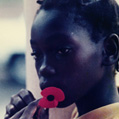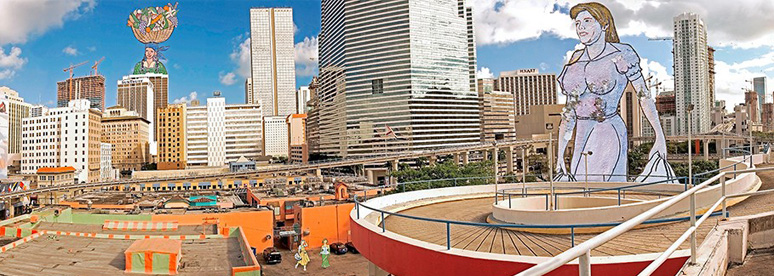PAST EXHIBITION

Portraits
Selections from AMA's Collection
February 21, 2009 – April 12, 2009
ABOUT THE EXHIBIT
Portraits in the collection of the Art Museum of the Americas present an eclectic cross section of mostly anonymous subjects- individuals representing diverse social groups of the region. Those two characteristics bring to mind the spirit of two master photographers. The German August Sander (1876-1964), who in his extended survey of the German people represented types and groups of people rather than individuals; and the American photographer Paul Strand (1890-1976), who photographed people to reveal the core of their humanity.
Similarly, the photographs, selected from the museum’s permanent collection reflect strong social characteristics. For instance, Mexican Pedro Meyer portrays the working classes of the Americas. Meyer is an accomplished photographer who embraced the digital photography in its early years, traveling extensively and documenting people and their circumstances. In many areas of his work, he veils his social criticisms with humor. These ten environmental portraits were selected from his digital archives and donated to the museum as part of the 2007 global exhibit Herejias. The common denominator in Meyer’s portraits lies in their backgrounds, which are commentaries on the social conditions or attributes of their subjects. In his picture titled La Calaca Catrina: A Homage to Jose Guadalupe Posada (1979), the room service maid with towels is in some way similar to the famous character of the Jose Guadalupe Posada woodcut that inspired Diego Rivera and the Mexican muralists, and is a clear example of his humorous social criticism.
After fifty years of growth in the collection, there are some exceptions to the subjects’ anonymity ; like in the group portrait set during a mass by the Mexican photojournalist Fabricio Leon Dias, titled Reunion del Grupo Esquipulas II: Nicaragua, El Salvador, Guatemala, Honduras y Costa Rica (1987) we recognize Central American leaders. The only individual portrait in the exhibit that was made with the intention to represent a well known person is Jorge Luis Borges (1973-2000) by Pedro Meyer. With a witty approach to portraying famous people and his post-modern style, Luis Delgado portrays the bust of Carlos Gardel in a diptych composition titled Gardel en la Chacarita (2007). Mr. Delgado departing from Gardel’s full body sculpture and working in the negative space creates his profile against the bright sun, and pairing it with a picture of Gardel’s statue’s shadow where a white dove is taking off from the ground evokes the constant re-birth of his legacy.
In a similar crossroad of Sander and Strand, Fausto Ortis’s Shadows of Iron (2004) portrays an almost invisible social group: the Haitian working illegally in the Dominican Republic as anonymous heroes. Mr. Ortiz’s work is a sequenced triptych where the subject moves away until he is just a shadow.
In the same line of environmental portraits, Rossana Lacayo’s Fiesta de Catarina takes us into the interior of a hen-house where a young girl proudly holds a fight-cock on her arms. Ms. Lacayo is a photographer, video artist and social activist whose documents of Nicaragua’s festivities and marginal groups bring the intimacy and reality of her people into the picture. On the other hand, Daniel Muchiut takes us to the heart of the pampas, to Chivilcoy, Provincia de Buenos Aires, Argentina. Muchiut leads us in to the interior (with El Cantante) and exterior of a rural bar in his home district with untitled. In Lacayo and Muchuit’s interiors, the subjects stare into the camera while sitting and holding something that identifies them and communicates directly with the viewer. In El Cantante, the walls of the bar are covered with cultural icons from Carlos Gardel to Marilyn Monroe, validating the artistic status of El Cantante. Guatemalan Jaime Permuth traveled with the circus in his native land, capturing the spontaneity of the moment with acrobats performing and rehearsing, family members on motorcycles, and in the intimacy of the camarines (the last part?). The dignity and humanity of these fascinating performers is clear through his photographs.
In the realm of the self-portrait, Diego Cifuentes’ Maquina de Violencia I renders the artist with a wounded heart via digital manipulation before corpses in the city morgue. In the picture, Cifuentes appears to be disturbed by the endemic violence in his native Ecuador.
Group portraits are important to the portrait tradition, as groups of anonymous individuals, commemoratives or not, pose or spontaneously they tell stories about their common causes and physical appearances, and identification with one another. That is the case in Las Prenadas (1982) by Venezuelan Carlos German Rojas, Compadres (1982) by Chilean Lincoyan Parada and Cholos (1986) by Mexican Graciela Iturbide. As in the Sindicato de Taxistas by Pedro Meyer, the subjects on these pictures have strong similarities.
In the symbolic portrait of Leo Matiz, the artist shares his nostalgia for the years when he lived in Mexico and was part of the cultural movement of the 40’s and 50’s. He takes us back to Cocayan in 1996, to photographs of an Italian model wearing Frida Kahlo’s dresses in front of her former house., which is now a Kahlo museum, revisiting and re-photographing part of a common Latin-American past. In a similar revisiting of American common past, Raul Stolkiner evokes the 1887 campaign of General Julio Argentino Roca against the natives of the Patagonia. In his picture titled A Lito..., General Roca’s central station appears in the background before an unfinished highway symbolizing the broken promises for a prosperous future, while in the night sky there is a person looking through a telescope holding a picture in reference to Antonio Posso (Lito)the Italian photographer that documented Roca’s campaign.
Revisiting is also Jose Manuel Mayorga’s theme. In his cartes de visite, he renders a couple of native women from the audiences of the Peace Accord in 1996. He references the first ethnographic work of German photographer Emil Herbruger Wheling,who in 1865 photographed native Guatemalan people, giving one copy to his subjects and selling other copies as carte de visite (collectibles-card) with a brief ethnographic text in the back written for the foreign buyer.In his work, he also refers to the capacity of the native women for literacy and active participation in politics.
Karla Turcios takes ownership of Miami, Florida in her digital-photo montage titled Miami es Mia. Her panoramic views of the ever-changing urban landscape inhabited by larger than life latinas taking over the city as graffiti takes over a public a wall in an open space. “Here we are,” Karla says, “we are visible, we are looking good, and we are here to stay; by rescuing them from a flaking exterior wall and pasting in an ever-changing digital world.”
Portraits of youths by two well-known Caribbean photographer the Jamaican Owen Minott, Girl with a Poppy (C. 1988) and Dominican Domingo Batista’s Untitled (1989) illustrate and frame the idea that it is not the person who transcends, but the group that they represent and the art form that represents them.

